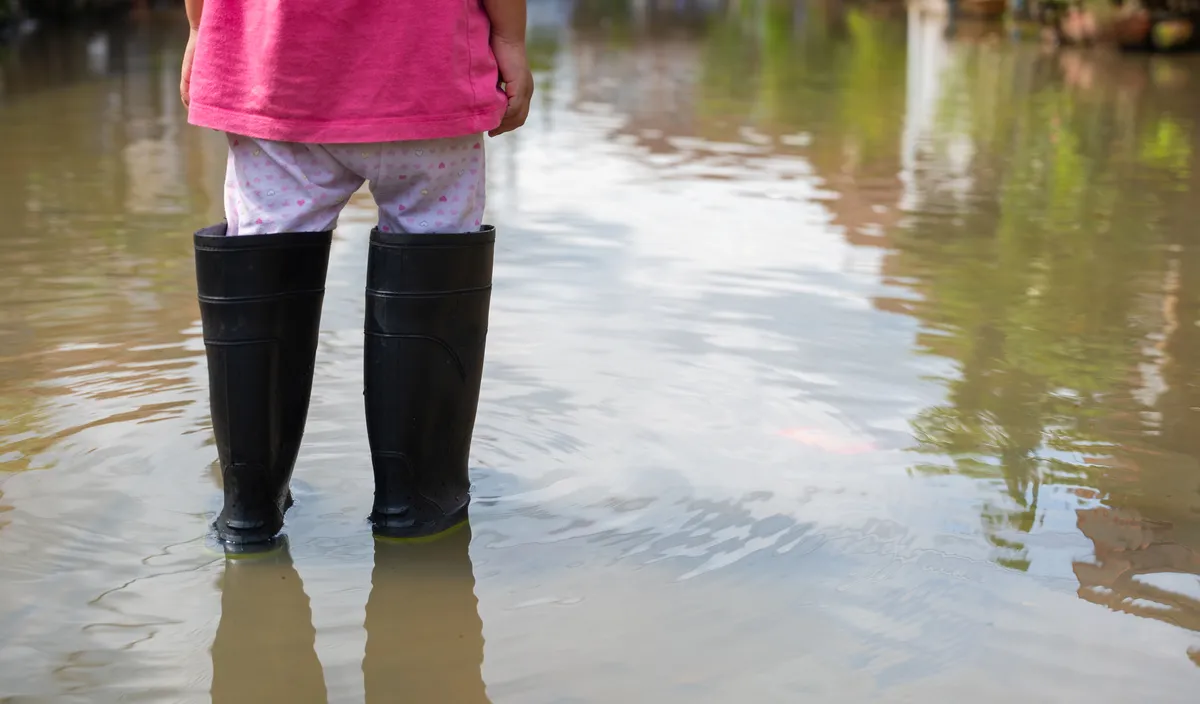👋 We often think about climate change as an adult problem: What happens if our home is damaged by storm, flood, or fire? How can I reduce my family’s carbon footprint? What mess are we leaving for our kids when they grow up?
But climate change is a problem for kids now — whether they live in a coastal area, near fire-prone forests, or in a city that holds onto heat and pollution. That hit home for me this summer, when the heavy smoke from Canadian wildfires meant bringing masks for my kids to wear at school and cancellation of their recess and activities. I got just a small taste of what families across the country have been going through for years.
For my 8- and 10-year-old sons, climate is deeply personal. They worry about the harm we’re doing and what their futures will hold.
This issue of Starting Early looks at how climate change affects the first 1,000 days — from pregnancy through age 3 — and what we can do now to better manage the impact of climate change today and in the future. We also have an interview with child and family policy expert Elliot Haspel, who believes solving climate change requires us to think even more intentionally about young children, mobilize our communities, and direct more resources to people threatened most.
Atiya Weiss
Executive Director, the Burke Foundation
1 big thing: climate change is here…and it’s harming young children now

The more than 23 million children under 5 in the US are uniquely dependent on parents and caregivers and their communities to survive. They’re highly vulnerable in the face of climate change and major weather events.
By the numbers: Babies’ bodies are 75% water. Extreme heat can dissipate that water, quickly affecting core functions of life. And temperatures are rising across most of the US – with the pace accelerating since 1979.
With higher temperatures comes more volatile weather:
- 9 of the 10 warmest years on record for the contiguous 48 states occurred since 1998; 2012 and 2016 were the 2 warmest yet.
- Heat waves in major US cities increased from an average of 2 per year in the 1960s to 6 during the 2010s and 2020s.
- 9 of the top 10 years for extreme 1-day precipitation events occurred since 1996.
Why it matters: Babies and children often spend their days in facilities that can’t keep up with the heat or are unavailable due to extreme weather. They may be forced to stay indoors during a time of year when they have the greatest opportunity to play. Their parents increasingly work in high temperatures that leave them drained or they lose work due to closures. Climate change contributes to extreme stress on families, which places greater stress on communities.
Go deeper: A groundbreaking report by Capita and the Aspen Institute calls for placing children and families at the center of all planning at the federal, state, municipal, and business levels. The report offers a wide range of recommendations for public and private action, including:
✅ Try new funding strategies: Require early year set-asides in all federal programs related to climate change; designate funding for outdoor learning spaces; foster business partnerships to fund infrastructure improvements.
✅ Increase accountability: Create a national scorecard on the state of children and the climate; strengthen air quality and extreme heat standards, recommendations, and alerts.
✅ Improve facilities: Ensure that the Child Care and Development Block Grant Act supports climate mitigation, adaptation, and resilience; help communities provide more shade in areas with children; expand access to climate resilience hubs.
✅ Enlist the medical community: Provide more help and higher reimbursement for doulas and other birth-support professionals to support expecting parents in a changing climate.
3 questions about kids and climate for Elliot Haspel

Elliot Haspel, director of climate and young children at Capita – an organization focused on building a future in which all children and families flourish — is a child and family policy expert and author. He was a driving force behind the Early Years Climate Action plan released last month by Capita and the Aspen Institute. The report was informed by a task force of representatives from the education and health sectors, current and former elected officials in state and tribal government, parent leaders, and early childhood advocates.
Elliott shares his perspective on the importance of centering climate action on young children and families to benefit all.
What are the effects of climate change on young children?
There are direct effects on young children themselves, on their families, and on some of the systems they interact with, like child care and pediatric healthcare. Climate change is a context more than an issue. Almost every effect of climate change on health and well-being is exacerbated in young children because of their developing brains and bodies. Sometimes we think about little children as though they’re little adults, but they’re not. Their brains work differently. Their bodies work differently. That’s even compared to older youth, too.
Extreme heat is a good example. Young children can dehydrate faster and get heat stroke faster than older kids because a higher proportion of their body is made up of water, and they have more immature kidneys.
And exposure to air pollution in young children is linked not only to asthma and respiratory illness, but also to increased risks of mental illness and mental health challenges later in life.
Psychologically, young children experience more trauma and have a longer and harder time recovering from climate-enhanced extreme weather events than older children or adults do.
Then there are effects on the families. An extreme precipitation event that causes flooding can disrupt households and businesses where parents work. Those have knock-on effects because young children’s development is inextricably tied up in the well-being of their family and their household.
The more climate change threatens child care facilities, whether it’s through extreme heat, flooding, fire, or hurricane, the more it will have a negative effect on families.
Why is it important to look at climate change through an early childhood lens?
When we think about how climate change affects young children and how we might invest in them, it leads us down a path to better recognize what’s needed to get the entire community ready. We want to protect children from harm coming from climate change, but we recognize that it’s also an opportunity to reframe and reimagine a lot of our societal systems — not just for the future, but for the present. All the things you want to do to help children thrive in a changing climate — from having adequate shade and access to nature, to minimizing air pollution to having healthy buildings to providing mental health supports for caregivers and early years providers — are things that help everyone thrive.
Young children are often overlooked in climate discussions. Services for the early years are extraordinarily fragmented. When you’re doing a climate action plan for a city, the early years are an afterthought or not part of the conversation at all.
How did the recently-released US Early Years Climate Action Plan come about and what are some key recommendations?
Last year, Capita and This is Planet Ed at the Aspen Institute convened leaders from early childhood, pediatrics, climate action, research, and philanthropy, as well as parents, as a learning-focused task force. They held public listening sessions with people from the field and on the front lines, domestically and internationally, to understand the nexus of the early years and climate change. The resulting action plan has recommendations for federal, state, and local government leaders; early years providers; the business community; researchers; and philanthropy.
One recommendation is to make sure there’s access to such birth supports as midwives and doulas who are trained about climate change. They can often build trusting relationships with people from historically-disenfranchised communities who may have a negative relationship with the traditional medical establishment. They can ask families, “How prepared is your home? What is your air filtration system like? Is your basement likely to flood? Do you have a plan if there’s an extreme precipitation event?”
It would also be helpful to make talking about climate change a Medicaid reimbursable expense as part of the well-child visit. As half of all babies in this country are covered by Medicaid, it becomes a particularly important lever of public policy.
Facility funding is also important. We need to make sure early-years facilities can withstand this predictably unpredictable era we’re in. It means they need to have HVAC systems strong enough so they don’t blow out when there’s a heat wave. If it’s a family childcare provider in a basement in New York, it needs a solid enough literal foundation that the program won’t flood out when there’s an extreme weather event.
🔊 Listen in: For more from Elliot Haspel, check out this podcast episode on incorporating climate resilience and sustainability in early care and education settings.
3. Tools you can use

These tools will help families prepare for and talk about climate change:
- Looking for a basic preparation checklist and an explanation of the link between extreme weather and climate change? Try this resource from healthychildren.org.
- Here are some age-appropriate ways to help children better understand and address climate change.
- Reading together can help kids understand the changing environment. This list from Time includes books to foster a child’s love for nature, including Thank You, Earth: A Love Letter to Our Planet by April Pulley Sayre and Fatima’s Great Outdoors by Ambreen Tariq. This list from Hitchcock Center, a Massachusetts conservation organization, includes picture books like To Change a Planet by Christina Soontornvat and The Bear Report by Thyra Heder.
- How does your city’s green space stack up? ParkScore from Trust for Public Land ranks cities on green space equity, access, investment, amenities, and acreage.
The roundup
- Growing our team: The Burke Foundation is hiring a program officer for Early Relational Health, child care, and family economic security and well-being.
- Building resilient communities: The 2nd Annual New Jersey Rural Health Conference on November 9 will bring together experts from around the state.
- Learning together: ZERO-TO-THREE’s December 5-6 LEARN Institute features 6 tracks, including one focused on climate change and the environment.
- Collaborating for change: Aspen Ideas: Climate 2024 will gather 100+ climate leaders, innovators, educators, and artists to discuss climate solutions that have the chance to make an incredible impact.
